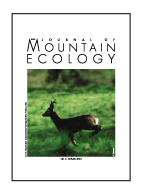

No. 6 - Autumm 2001

- MALE
AND FEMALE SPATIAL BEHAVIOUR OF ROE DEER IN A MOUNTAINOUS HABITAT
DURING PRE-RUTTING AND RUTTING PERIOD
I. Rossi, P. Lamberti, L. Mauri & M. Apollonio
- TRACKING
48 AND 150 MHZ RADIO-TAGGED MALE LAKE-TROUT DURING
THEIR SPAWNING MIGRATION IN A MOUNTAIN REGULATED RIVER
G. Monet & I. Soares
- WINTER
MOVEMENTS OF THE ALPINE CHOUGH: IMPLICATIONS
FOR MANAGEMENT IN THE ALPS
P. Laiolo, A. Rolando & L. Carisio
- ON THE STATUS AND BIOLOGY OF THE WILD GOAT IN
DAGHESTAN (RUSSIA)
P. Weinberg
- THE
DUNG BEETLES OF GRAN PARADISO NATIONAL PARK:
A PRELIMINARY ANALYSIS (INSECTA: COLEOPTERA: SCARABAEOIDEA)
L. Borghesio , C. Palestrini & P. Passerin d’Entrèves